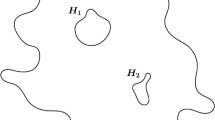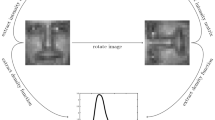Abstract
Nowadays, an objective in visual communication is to send and store images of faces at a low bit rate, such that the faces are still recognizable and that the compression does not prevent remote face analysis. We present a novel segmented face approximation algorithm. Greyscale face images are segmented into meaningful surface segments with an adaptive region growing algorithm based on low-degree polynomial fitting. The algorithm uses a new adaptive thresholding technique with the \(L_\infty \) fitting cost as a segmentation criterion. The polynomial degree and the fitting error are automatically adapted during the region growing process. The main novelty is that the algorithm detects outliers and edges, distinguishes between strong and smooth intensity transitions, and finds surface segments that are bent in a certain way, such as flat, planar, convex, concave or saddle patches. As a result, the surface segments correspond to facial features, and the contours separating the surface segments coincide with real image face edges. Moreover, the curvature-based surface shape information facilitates many tasks in automated face analysis, demonstrated in this paper by face verification performed on the polynomial representation. The polynomial representation provides good approximation of facial features, while preserving all the necessary details of the face in the reconstructed image. When compared with different compression methods, we achieve higher compression ratios and better recognizable faces at low bit rates. This is confirmed by correct identification percentages obtained by face recognition algorithms on the compressed data.


















Similar content being viewed by others
Notes
Remember that during region growing, only the fitting cost was computed.
Abbreviations
- \(p\) :
-
Pixel
- \(S\) :
-
Segment
- \(d\) :
-
Polynomial degree
- \(r(S)\) :
-
Minimal fitting cost over \(S\)
- \(\tilde{r}(S)\) :
-
Estimated fitting cost over \(S\)
- \(D\) :
-
Elemental subset
- \(M\) :
-
Number of elemental subsets
- \(\tilde{r}(S_i; p_i)\) :
-
Estimated fitting cost of adding \(p_i\) to \(S_i\)
- \(p_k\) :
-
New pixel
- \(X_k\) :
-
Local behaviour measure of fitting costs
- \(R_k\) :
-
Local neighbourhood of \(p_k\)
- \(T_X\) :
-
Threshold on \(X_k\)
- \(Y_k\) :
-
Global behaviour measure of fitting costs
- \(T_Y\) :
-
Threshold on \(Y_k\)
References
Adams, R., Bischof, L.: Seeded region growing. IEEE Trans. Pattern Anal. Mach. Intell. 16(6), 641–647 (1994)
Aharon, M., Elad, M., Bruckstein, A.: The k-svd: an algorithm for designing of overcomplete dictionaries for sparse representation. IEEE Trans. Signal. Process. 54, 4311–4322 (2006)
Alani, D., Averbuch, A.: Dekel S Image coding with geometric wavelets. IEEE Trans. Image Process. 16(1), 69–77 (2007)
Aravind, I., Chaitanya, C., Guruprasad, M., Partha, S., Sudhaker, S.: Implementation of image segmentation and reconstruction using genetic algorithms. In: IEEE International Conference on Industrial Technology, pp. 970–975 (2002)
Bartlett, M., Donato, G., Movellan, J., Hager, J., Ekman, P., Sejnowski, T.: Image representations for facial expression coding. Adv. Neural Inf. Process. Syst. 12, 886–892 (2000)
Biswas, S.: Segmentation based compression for gray-level images. Pattern Recogn. 36(7), 1501–1517 (2003)
Bosworth, J., Acton, S.: Segmentation-based image coding by morphological local monotonicity. In: Conference on Signals, Systems and Computers, pp. 65–69 (2000)
Bryt, O., Elad, M.: Compression of facial images using the K-SVD algorithm. J. Vis. Commun. Image R 19, 270–282 (2008)
Candès, E.J., Donoho, D.L.: Curvelets: a surprisingly effective nonadaptive representation for objects with edges. In: Curves and Surfaces, pp. 1–10 (1999)
Canny, J.: A computational approach to edge detection. IEEE Trans. Pattern Anal. Mach. Intell. 8, 679–698 (1986)
Christopoulos, C., Philips, W., Skodras, A., Cornelis, J.: Segmented image coding: techniques and experimental results. Signal Process. Image Commun. 11, 63–80 (1997)
Comaniciu, D., Meer, P.: Mean shift: a robust approach toward feature space analysis. IEEE Trans. Pattern Anal. Mach. Intell. 24(5), 603–619 (2002)
Couprie, C., Grady, L., Najman, L., Talbot, H.: Power watershed: a unifying graph-based optimization framework. IEEE Trans. Pattern Anal. Mach. Intell. 33(7), 1384–1397 (2011)
Deboeverie, F., Teelen, K., Veelaert, P., Philips, W.: Adaptive constructive polynomial fitting. In: Proceedings of Advanced Concepts for Intelligent Vision Systems, pp. 173–184 (2010)
Deboeverie, F., Veelaert, P., Philips, W.: Face analysis using curve edge maps. In: Proceedings of International Conference on Image Analysis and Processing, pp. 109–118 (2011)
Do, M.N., Vetterli, M.: Contourlets. In: Stoeckler, J., Welland, G.V. (eds.) Beyond Wavelets. Academic, San Diego (2003)
Donoho, D.L.: Wedgelets: nearly minimax estimation of edges. Ann. Stat. 27(3), 859–897 (1999)
Donoho, D.L., Huo, X.: Beamlets and multiscale image analysis. Technical report, Department of Statistics, Stanford University, Stanford, CA (2001)
Eden, M., Kocher, M.: On the performance of a contour coding algorithm in the context of image coding part 1: contour segment coding. Signal Process. 8, 381–386 (1985)
Elad, M., Goldenberg, R., Kimmel, R.: Low bit-rate compression of facial images. IEEE Trans. Image Process. 16(9), 2379–2383 (2007)
Gerek, O.N., Çinar, H.: Segmentation based coding of human face images for retrieval. Signal Process. 84, 1041–1047 (2004)
Gersho, A., Gray, R.: Vector Quantization and Signal Compression. Kluwer Academic Publishers, Dordrecht (1995)
Gilge, M., Engelhardt, T., Mehlan, R.: Coding of arbitrarily shaped image segments based on a generalized orthogonal transform. Signal Process. Image Commun. 1(2), 153–180 (1989)
Hu, J., Wang, R., Wang, Y.: Compression of personal identification pictures using vector quantization with facial feature correction. Opt. Eng. 35, 198–203 (1996)
Jackway, P.: Gradient watersheds in morphological scalespace. IEEE Trans. Image Process. 15(6), 913–921 (1996)
Kanga, C.C., Wanga, W.J., Kangb, C.H.: Image segmentation with complicated background by using seeded region growing. Int. J. Electron. Commun. (2012). doi:10.1016/j.aeue.2012.01.011
Kassim, A.A., Lee, W.S., Zonoobi, D.: Hierarchical segmentation-based image coding using hybrid quad-binary trees. IEEE Trans. Image Process. 6, 1284–1291 (2009)
Kunt, M., Ikonomopoulos, A., Kocher, M.: Second generation image coding. Proc. IEEE 73(4), 549–574 (1985)
Kunt, M., Benard, M., Leonardi, R.: Recent results in high-compression image coding. IEEE Trans. Circ. Syst. 34(11), 1306–1336 (1987)
Lambert, J.: Photometria Sive de Mensura de Gratibus Luminis. Colorum et Umbrae. Eberhard Klett, Augsberg (1760)
Lanitis, A., Taylor, C.J., Cootes, T.F.: Automatic interpretation and coding of face images using flexible models. IEEE Trans. Pattern Mach. Intell. 19(7), 743–756 (1997)
Li, H., Roivainen, P., Forchheimer, R.: 3-d motion estimation in model-based facial image coding. IEEE Trans. Pattern Anal. Mach. Intell. 15(6), 545–555 (1993)
Lyons, M., Akamatsu, S.: Coding facial expressions with Gabor wavelets. In: Proceedings of Third IEEE International Conference on Automatic Face and Gesture Recognition, pp. 200–205 (1998)
Martinez, A., Benavente, R.: The ar face database. Technical report. CVC Technical, Report # 24 (1998)
Maxwell, B.A., Shafer, S.A.: Segmentation and interpretation of multicolored objects with highlights. Comput. Vis. Image Underst. 77, 1–24 (2000)
Moghaddam, B., Pentland, A.: An automatic system for model-based coding of faces. In: IEEE Data Compression Conference, pp. 362–370 (1995)
Muñoz, X., Freixenet, J., Cufí, X., Martí, J.: Strategies for image segmentation combining region and boundary information. Pattern Recogn. Lett. 24(1–3), 375–392 (2003)
Pappas, T.N.: An adaptive clustering algorithm for image segmentation. IEEE Trans. Signal Process. 40(4), 901–914 (1992)
Pennec, E.L., Mallat, S.: Sparse geometric image representations ith bandelets. IEEE Trans. Image Process. 14(4), 423–438 (2005)
Philips, W.: Fast coding of arbitrarily shaped image segments using weakly separable bases. Opt Eng Special Sect. Vis. Commun. Image Process. 35, 177–186 (1996)
Pohle, R., Toennies, K.D.: Proceedings of spie medical imaging. In: Segmentation of medical images using adaptive region growing, pp. 1337–1347 (2001)
Psychological image collection at stirling (pics) (n.d.). http://www.pics.stir.ac.uk
Qin, A.K., Clausi, D.A.: Multivariate image segmentation using semantic region growing with adaptive edge penalty. IEEE Trans. Image Process. 19(8), 2157–2170 (2010)
Radha, H., Vetterli, M., Leonardi, R.: Image compression using binary space partitioning trees. IEEE Trans. Image Process. 5(12), 1610–1624 (1996)
Reid, M.M., Millar, R.J., Black, N.D.: Second-generation image coding: an overview. ACM Comput. Surv. 29(1), 3–29 (1997)
Ruppertsberg, A.I., Vetter, T., Bülthoff, H.H.: A face specific similarity measure for image coding and synthesis. Investig. Ophthalmol. Vis. Sci. 39(4), 173 (1998)
Sakalli, M., Yan, H.: Feature-based compression of human face images. Opt. Eng. 37, 1520–1529 (1998)
Salembier, P., Brigger, P., Casas, J., Pardas, M.: Morphological operators for image and video compression. IEEE Trans. Image Process. 5(6), 881–898 (1996)
Samet, H.: The quadtree and related hierarchical data structures. ACM Comput. Surv. 16(2), 187–260 (1984)
Shi, J., Malik, J.: Normalized cuts and image segmentation. IEEE Trans. Pattern Anal. Mach. Intell. 22(8), 888–905 (2000)
Shukla, R., Dragotti, P.L., Do, M.N., Vetterli, M.: Rate-distortion optimized tree-structured compression algorithms for piecewise polynomial images. IEEE Trans. Image Process. 14(3), 343–359 (2005)
Sikora, T.: Trends and perspectives in image and video coding. Proc. IEEE 93(1), 6–17 (2005)
Sim, K., Hartley, R.: Removing outliers using the \(l_\infty \) norm. In: Proceedings of Computer Vision and, Pattern Recognition, pp. 485–494 (2006)
Somasundarama, K., Palaniappan, N.: Adaptive low bit rate facial feature enhanced residual image coding method using spiht for compressing personal id images. Int. J. Electron. Commun. 65, 589–594 (2011)
Sullivan, G.J., Baker, R.L.: Efficient quadtree coding of images and video. IEEE Trans. Image Process. 3(3), 327–331 (1994)
Taubman, D., Marcellin, M.: JPEG2000: Image Compression Fundamentals, Standards and Practice. Kluwer, Norwell (2002)
Tou, J.T., Gonzalez, R.C.: Pattern Recognition Principles. Addison-Wesley, Reading (1974)
Turk, M., Pentland, A.: Eigenfaces for recognition. J. Cognit. Neurosci. 3(1), 71–86 (1991)
Veelaert, P.: Constructive fitting and extraction of geometric primitives. CVGIP Graph. Models Image Process. 59(4), 233–251 (1997)
Veelaert, P.: Separability and tight enclosure of point sets, digital geometry algorithms. Theor. Found. Appl. Comput. Imag. 2, 215–243 (2012)
Veelaert, P., Teelen, K.: Fast polynomial segmentation of digitized curves. In: Proceedings of Discrete Geometry for Computer Imagery, pp. 482–493 (2006)
Vila-Forcén, J.E., Voloshynovskiy, S., Koval, O., Pun, T.: Facial image compression based on structured codebooks in overcomplete domain. EURASIP J. Appl. Signal Process. 2006, 1–11, Art ID 69042 (2006)
Viola, P., Jones, M.: Rapid object detection using a boosted cascade of simple features. In: Proceedings of Computer Vision and, Pattern Recognition, pp. 511–518 (2001)
Wagemans, J., Doorn, A.J.V., Koenderink, J.: The shading cue in context. i-Perception 1(3), 159–178 (2010)
Willett, R., Nowak, R.: Platelets: a multiscale approach for recovering edges and surfaces in photon-limited medical imaging. IEEE Trans. Med. Imag. 22(3), 332–350 (2003)
Yemez, Y., Sankur, B., Anarim, E.: An object-oriented video codec based on region growing motion segmentation. In: Proceedings of International Conference on Image Processing, pp. 444–447 (1997)
Yoo, H.W., Junga, S.H., Janga, D.S., Nab, Y.K.: Extraction of major object features using VQ clustering for content-based image retrieval. Pattern Recogn. 35, 1115–1126 (2002)
Acknowledgments
The work was financially supported by iMinds and IWT through the Project ‘iCoCoon’ and by FWO through the Project G.0.398.11.N.10 ‘Multi-camera human behavior monitoring and unusual event detection’.
Author information
Authors and Affiliations
Corresponding author
Rights and permissions
About this article
Cite this article
Deboeverie, F., Veelaert, P. & Philips, W. Segmented face approximation with adaptive region growing based on low-degree polynomial fitting. SIViP 9, 347–363 (2015). https://doi.org/10.1007/s11760-013-0441-6
Received:
Revised:
Accepted:
Published:
Issue Date:
DOI: https://doi.org/10.1007/s11760-013-0441-6




